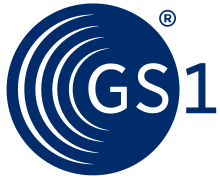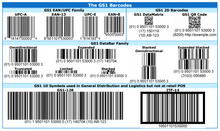GS1
GS1 is a not-for-profit organization that develops and maintains global standards for business communication. The best known of these standards is the barcode, a symbol printed on products that can be scanned electronically. GS1 barcodes are scanned more than six billion times every day.
 | |
| Not-for-profit organisation | |
| Industry | Standards |
| Founded | 26 April 1974 |
| Headquarters | Brussels, Belgium |
Number of locations | More than 114 offices worldwide[1][2] |
Key people | Miguel A. Lopera (CEO) |
| Website | www |
GS1 has 114 local member organisations and 1.5 million user companies.
GS1 standards are designed to improve the efficiency, safety and visibility of supply chains across physical and digital channels in 25 sectors. They form a business language that identifies, captures and shares key information about products, locations, assets and more.
History

In 1969, the retail industry in the US was searching for a way to speed up the check-out process in shops. The Ad Hoc Committee for a Uniform Grocery Product Identification Code was established to find a solution.
In 1973, the Universal Product Code (UPC) was selected by this group as the first single standard for unique product identification, and in 1974, the Uniform Code Council (UCC) was founded to administer the standard.[1] On 26 June 1974, a pack of Wrigley’s chewing gum became the first ever product with a barcode to be scanned in a shop.[1][3]
In 1976, the original 12-digit code was expanded to 13 digits, which opened the doors for the identification system to be used outside the U.S. In 1977, the European Article Numbering Association (EAN) was established in Brussels and with founding members from 12 countries.[4]
In 1990, EAN and UCC signed a global cooperation agreement and expanded overall presence to 45 countries. In 1999, EAN and UCC launched the Auto-ID Centre to develop Electronic Product Code (EPC) enabling GS1 standards to be used for RFID.[5]
In 2004, EAN and UCC launched the Global Data Synchronization Network (GDSN), a global, internet-based initiative that enables trading partners to efficiently exchange product master data.[4]
By 2005, the organisation was present in over 90 countries which started to use the name GS1 on a worldwide basis. Whilst "GS1" is not an acronym it refers to the organisation offering one global system of standards.[4]
Aug 2018 - GS1 Web URI Structure Standard is ratified allowing unique ID's to be added to products by storing a URI (a webpage-like address) as a QR code.[6]
Barcodes

Barcodes defined by GS1 standards are very common.[7] GS1 introduced the barcode in 1974.[8] They encode a product identification number that can be scanned electronically, making it easier for products to be tracked, processed, and stored.
Barcodes allow for greater safety, reliability, speed and efficiency of supply chains. They have a crucial role in the retail industry, moving beyond just faster checkout to improved inventory and delivery management and the opportunity to sell online on a global scale. In the UK alone, the introduction of the barcode in the retail industry has resulted in savings of 10.5 billion pounds per year.[1][9]
Some of the barcodes that GS1 manages are: EAN/UPC (used mainly on consumer goods), GS1 Data Matrix (used mainly on healthcare products), GS1-128, GS1 DataBar, and GS1 QR Code.
Standards
The most important GS1 standard is the GTIN. It identifies products uniquely around the world and forms the base of the GS1 system.
Main GS1 standards are as follows:
- Application Level Events (ALE)
- Core Business Vocabulary (CBV)
- EAN/UPC barcodes
- EPC/RFID tags
- EPCIS
- GEPIR
- Global Data Synchronization Network (GDSN)
- Global Document Type Identifier (GDTI)
- Global Individual Asset Identifier (GIAI)
- Global Identification Number for Consignment (GINC)
- Global Location Number (GLN)
- Global Product Classification (GPC)
- Global Returnable Asset Identifier (GRAI)
- Global Service Relationship Number (GSRN)
- Global Shipment Identification Number (GSIN)
- Global Trade Item Number (GTIN)
- GS1-128
- GS1 DataBar
- GS1 DataMatrix
- GS1 EDI
- ITF-14
- Low-Level Reader Protocol (LLRP)
- Object Name Service (ONS)
- Serial Shipping Container Code (SSCC)
Many GS1 standards are also ISO standards. For example, the GTIN, GLN, and SSCC.[10]
GS1 also acts as the secretariat for ISO’s Automatic identification and data capture techniques technical committee (ISO/IEC JTC 1/SC 31).[11]
GS1 standards are developed and maintained through the GS1 Global Standards Management Process (GSMP), a community-based forum that brings together representatives from different industries and businesses. Together they find and implement standards-based solutions to address common supply chain challenges.
Industries
Retail
Retail was the first industry that GS1 began working with and has remained their primary focus. Today, GS1 operates in four retail sub-sectors on a global level: Apparel, Fresh Foods, CPG/Grocery and General Merchandise.
Key focus areas in retail include sustainability, data quality, compliance with regulatory requirements, trace-ability of products from their origin through delivery, and upstream integration between manufacturers and suppliers.
As consumers continue to switch between in-store and e-commerce shopping channels, a consistent shopping experience, efficiency, safety and speed are expected. GS1 has developed standards that uniquely identify products for the benefit of consumers and for search engines, providing accurate and complete product information digitally.[12]
Major e-commerce companies such as eBay, Amazon and Google Shopping require companies to use a GS1 number to sell on their websites.[13][14][15]
Healthcare
For many years, GS1 has operated in Healthcare with the primary objective to increase patient safety and drive supply chain efficiency.
Usage of GS1 standards in Healthcare support trace-ability of products from the manufacturer to the patient, contribute to detect counterfeit products, help to prevent medication errors, enable effective recalls and supports clinical processes.
Regulatory bodies across the world are mandating the implementation of GS1 standards for the above reasons as well for medicines as medical devices.[16]
Other industries
GS1 operates in four other key industries globally: Transport & Logistics, Food service, Technical Industries and Humanitarian Logistics. GS1’s Member Organisations in over 100 countries around the world collectively focus on over 25 industry sectors.[17]
Membership
GS1 has over 1.5 million members worldwide. Companies can become members by joining a local GS1 Member Organisation.
Governance and structure
GS1’s governance has three levels:
- First level - GS1 General Assembly, composed of representatives of all Member Organisations.
- Second level - GS1 Management Board responsible for global strategic direction (composed of key leaders from multinational businesses and GS1 Member Organisations). GS1’s management board members are individuals with senior positions in the following organizations:[18]
- Abudawood
- Amazon
- Alibaba Group
- B. Braun Melsungen
- Beijing Hualian Group
- bol.com
- Dr. Oetker
- Grupo Bimbo
- Grupo Éxito
- IGA
- The J.M. Smucker Company
- Johnson & Johnson
- L'Oréal
- LF Logistics
- Metro AG
- Nestlé
- Procter & Gamble
- Reliance Retail
- Royal College of Physicians and Surgeons of Canada
- Wendy's
- GS1 Global Office
- GS1 Australia
- GS1 Canada
- GS1 China
- GS1 Egypt
- GS1 France
- GS1 Germany
- GS1 Hong Kong
- GS1 Italy
- GS1 Paraguay
- GS1 UK
- GS1 US
- Third level - GS1 Global Office and the Local GS1 Member Organisations (MOs). The GS1 Global Office leads the development and maintenance of new standards. Local MOs focus on local services and standards implementation. Local GS1 Boards are responsible for local strategic directions (composed of key leaders from national companies).
There are also two other boards at the global level:
Financing
GS1 Member Organisations around the world are funded by their local members through annual membership fees and sales of services.
Partners
GS1 partners with other international organisations. Some of GS1’s partners are:
- Consumer Goods Forum[19]
- International Standards Organisation (ISO)[10]
- NATO[20]
- United Nations[21]
- UN Refugee Agency (UNHCR)[22]
- World Customs Organisation (WCO)
- International Society for Quality in Health Care (ISQua)
- Joint Initiative Council (JIC)
See also
References
- Harford, Tim (23 January 2017). "How the barcode changed retailing and manufacturing". BBC News. Retrieved 28 April 2017.
- https://www.gs1.org/articles/2510/gs1-grows-by-adding-two-new-member-organisations
- "The History of the Bar Code". Smithsonian. Retrieved 28 April 2017.
- "Historic Timeline - GS1 40th Anniversary". 40.gs1.org. Retrieved 28 April 2017.
- Anonymous (18 December 2014). "How we got here". www.gs1.org. Retrieved 28 April 2017.
- "GS1 Web URI Structure Standard" (PDF). GS1.
- Robertson, Gordon L. (19 April 2016). Food Packaging: Principles and Practice, Third Edition. CRC Press. ISBN 9781439862421.
- GS1 - Organisation that manages the barcode standard used by retailers, manufacturers and suppliers
- GS1UK (10 December 2013), Ever wondered what the GS1 barcode has done for you?, retrieved 28 April 2017
- "Organizations in cooperation with ISO". www.iso.org. Retrieved 28 April 2017.
- "ISO/IEC JTC 1/SC 31 - Automatic identification and data capture techniques". www.iso.org. Retrieved 28 April 2017.
- Communications, Edgell. "Tackling Disruptive Forces through Industry Collaboration". Retrieved 28 April 2017.
- "Product Identifiers | eBay Seller Center". pages.ebay.com. Retrieved 28 April 2017.
- "Amazon Announcement: Product UPCs and GTINs - RepricerExpress". www.repricerexpress.com. Retrieved 28 April 2017.
- "Reach more customers online: Add GTINs to your Google Shopping data feed". Google Commerce. Retrieved 28 April 2017.
- Anonymous (23 December 2014). "Healthcare". www.gs1.org. Retrieved 28 April 2017.
- "GS1 Strategy". www.gs1.org. Archived from the original on 17 January 2018. Retrieved 28 April 2017.
- "GS1 Management Board". Retrieved 5 March 2020.
- "Strategic Alliances of The Consumer Goods Forum". www.theconsumergoodsforum.com. Retrieved 28 April 2017.
- "NATO Update: NATO's Standardization Agency broadens cooperation - 31 Jan. 2006". www.nato.int. Retrieved 28 April 2017.
- "E/2015/INF/5 - E". undocs.org. Retrieved 28 April 2017.
- "World Customs Organization". www.wcoomd.org. Archived from the original on 19 September 2015. Retrieved 28 April 2017.